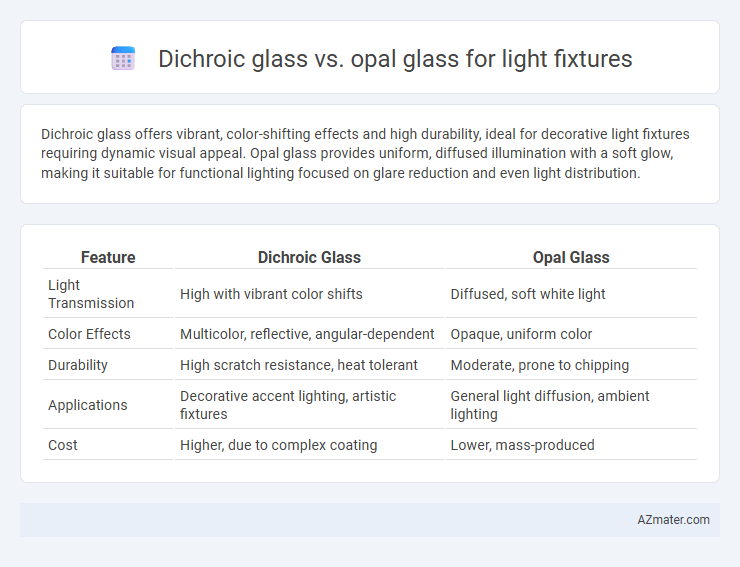Dichroic glass offers vibrant, color-shifting effects and high durability, ideal for decorative light fixtures requiring dynamic visual appeal. Opal glass provides uniform, diffused illumination with a soft glow, making it suitable for functional lighting focused on glare reduction and even light distribution.
Table of Comparison
| Feature | Dichroic Glass | Opal Glass |
|---|---|---|
| Light Transmission | High with vibrant color shifts | Diffused, soft white light |
| Color Effects | Multicolor, reflective, angular-dependent | Opaque, uniform color |
| Durability | High scratch resistance, heat tolerant | Moderate, prone to chipping |
| Applications | Decorative accent lighting, artistic fixtures | General light diffusion, ambient lighting |
| Cost | Higher, due to complex coating | Lower, mass-produced |
Introduction to Dichroic and Opal Glass
Dichroic glass features a multi-layer coating that reflects certain wavelengths of light while transmitting others, creating vibrant, shifting colors ideal for dynamic lighting effects in fixtures. Opal glass, composed of milky white or frosted glass, diffuses light evenly to produce a soft, uniform glow without glare. Choosing between dichroic and opal glass depends on the desired aesthetic and lighting quality, with dichroic glass offering color richness and opal glass emphasizing gentle illumination.
Composition and Manufacturing Process
Dichroic glass is composed of multiple ultra-thin layers of metal oxides deposited on a glass substrate through a precise vacuum deposition process, resulting in its characteristic color-shifting properties. Opal glass, primarily made from silica mixed with opacifying agents such as phosphates or fluorides, undergoes a melting and controlled cooling process that creates its uniformly diffused, milky appearance. The manufacturing of dichroic glass requires high-tech sputtering or vapor deposition methods for its spectral filtering layers, whereas opal glass is produced via traditional glass melting and opacification techniques for soft, even light diffusion in fixtures.
Optical Properties and Light Transmission
Dichroic glass features multiple ultra-thin layers of metal oxides that selectively filter and reflect specific wavelengths, resulting in vibrant color shifts and high spectral contrast ideal for decorative light fixtures. Opal glass offers uniform light diffusion with its milky, translucent composition, producing soft, glare-free illumination and consistent light transmission around 80-90%. While dichroic glass enhances visual impact through intense color effects and directional spectral control, opal glass prioritizes even light dispersion and reduced harshness in lighting applications.
Color Effects and Aesthetic Appeal
Dichroic glass produces vibrant, multi-colored effects by reflecting and transmitting different wavelengths of light, creating dynamic color shifts that enhance the aesthetic appeal of light fixtures. Opal glass provides a soft, diffused illumination with a milky white appearance, offering a consistent and elegant glow ideal for ambient lighting. While dichroic glass emphasizes bold, shifting hues for artistic impact, opal glass focuses on uniformity and subtlety to complement diverse interior designs.
Durability and Longevity
Dichroic glass offers superior durability in light fixtures due to its multiple micro-layers of metal oxides, which resist fading and corrosion under high heat and UV exposure. Opal glass, though prized for its diffuse light quality, is more prone to chipping and discoloration over time when exposed to frequent temperature fluctuations or mechanical impact. The longevity of dichroic glass typically exceeds that of opal glass, making it a preferred choice for fixtures requiring sustained aesthetic performance and minimal maintenance.
Applications in Light Fixture Design
Dichroic glass is preferred in light fixture design for creating dynamic color effects and enhancing ambiance through its multilayered coatings that reflect specific wavelengths of light. Opal glass, commonly used for diffusers, provides uniform, soft illumination by scattering light evenly, reducing glare in residential and commercial lighting. Designers select dichroic glass for accent lighting and artistic fixtures, while opal glass suits general or ambient lighting applications requiring smooth, diffused light distribution.
Energy Efficiency and Light Diffusion
Dichroic glass in light fixtures offers superior energy efficiency by reflecting specific wavelengths while transmitting others, reducing heat output and enhancing light utilization. Opal glass provides excellent light diffusion, creating even illumination with minimal glare but may slightly reduce luminous efficacy due to diffusion scattering. Choosing dichroic glass maximizes energy savings through spectral control, whereas opal glass prioritizes uniform light dispersion for comfortable environments.
Maintenance and Cleaning Considerations
Dichroic glass for light fixtures requires careful handling during maintenance due to its delicate multi-layered coatings that can be damaged by abrasive cleaners or excessive moisture. Opal glass offers easier cleaning with standard, non-abrasive household cleaners and is more resistant to surface scratches, making it a low-maintenance option for lighting applications. Both materials benefit from regular dusting and gentle cleaning methods to preserve their optical clarity and performance over time.
Cost Comparison and Value
Dichroic glass light fixtures typically have higher upfront costs due to their multi-layer coatings that produce vibrant, color-shifting effects, offering superior aesthetic value and energy efficiency. Opal glass fixtures, being more affordable, provide diffused and softer light but lack the dynamic color properties of dichroic glass, making them a cost-effective choice for simple, evenly lit spaces. When considering long-term value, dichroic glass often justifies its premium price with enhanced visual appeal and durability, while opal glass suits budget-conscious projects prioritizing uniform illumination.
Choosing the Right Glass for Your Light Fixture
Dichroic glass offers vibrant color shifts and enhanced light reflection, making it ideal for decorative light fixtures that emphasize artistic aesthetics and dynamic lighting effects. Opal glass provides soft, diffused illumination with excellent glare reduction, perfect for fixtures aiming to create a warm, even glow in residential or commercial spaces. Choosing the right glass depends on whether you prioritize vibrant color impact and light control (dichroic) or soft, uniform light diffusion with subtle design (opal).

Infographic: Dichroic glass vs Opal glass for Light fixture
 azmater.com
azmater.com